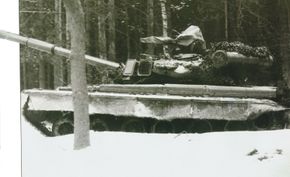Key Takeaways
- The T-80 Main Battle Tank, a continuation of the T-64 and T-72 series, introduced a gas turbine engine, enabling speeds up to 40 miles per hour.
- It features several variations, including different armor configurations like skirt armor over tracks, appliqué armor with radiation shields, and reactive armor, notably with one variant nicknamed "Dolly Parton" for its thicker mantlet armor.
- Despite its advancements, the T-80's potential weakness lies in its autoloading system for the 120mm main gun, raising concerns about mechanical complexity and crew fatigue due to maintenance demands.
Many consider the T-80 Main Battle Tank (MBT) to be no more than a variant of the T-72. Some even consider the "T-72" to be an export version and the T-80 to be the true T-72 MBT used by the Soviet armed forces.
The T-80 is a faster, more heavily armored tank than the T-72. The T-80 is powered by a gasoline turbine engine that gives the tank a ground speed in excess of 40 miles per hour. The tank is equipped with the Kobra missile system and can fire an antitank missile through its 125mm smoothbore gun.
Advertisement
An examination of the T-72's battle performance in Syrian hands during the Israeli invasion of Lebanon in 1982 led Soviet analysts to develop a program for up-armoring the T-64/T-72/T-80 series of MBTs.
Apparently, the laminate armor used in the hull was too vulnerable to the Merkava's 105mm main gun. Additional laminate armor that makes use of ceramic composites, as well as reactive armor, was noted on the T-80 and other Soviet tanks with Soviet forces in East Germany and Czechoslovakia.
In fact, by mid-1989 more than half the T-64/T-72/T-80 MBTs serving in Eastern Europe were clad in reactive armor. This development made obsolete as much as 80 percent of the one-man antitank weaponry in U.S./ NATO forces.
Reactive armor consists of steel boxes lined with explosives that are attached to the tank's hull and turret. When a high-explosive, antitank round strikes the reactive armor, the round's gas jet is disrupted by the explosives inside the box. Reactive armor is also said to be able to deflect solid-shot rounds in the same manner.
The Soviets designated the upgraded T-72 tank as the T-72 1981/3, which some Western sources refer to as the T-74 but NATO refers to as the T-80.
For more on T-80 Main Battle Tank equipment, continue to the next page.
Advertisement
